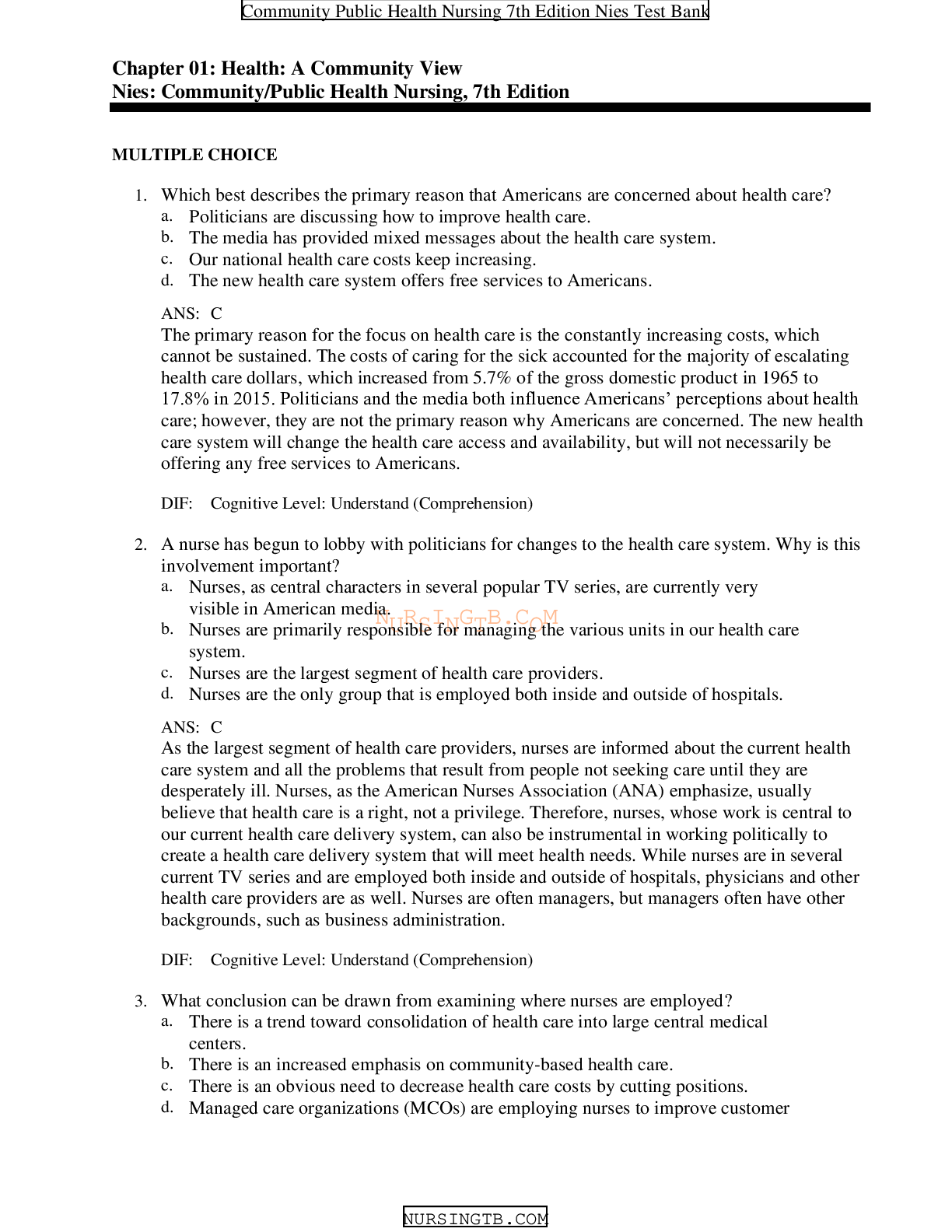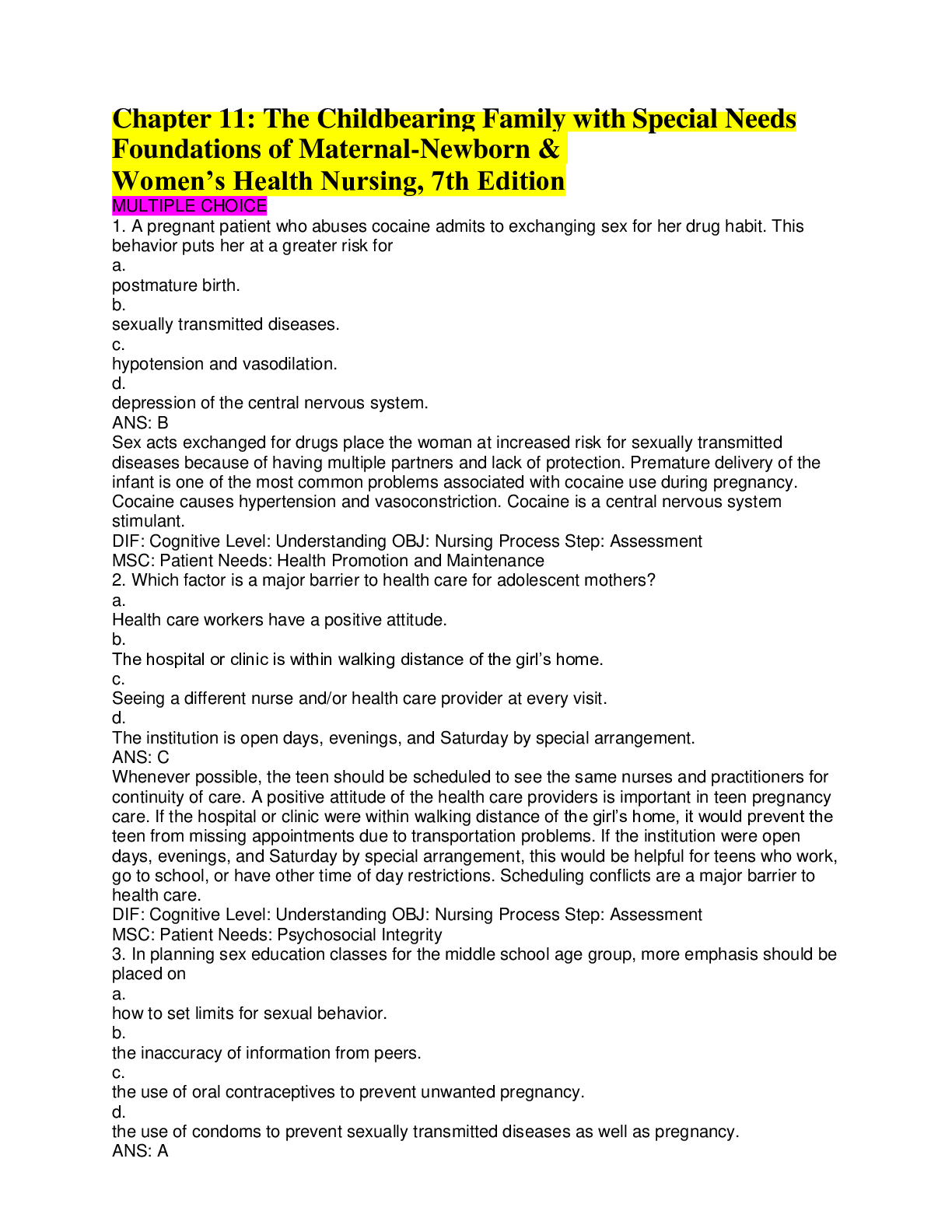*NURSING > TEST BANKS > Foundations of Maternal-Newborn and Women's Health Nursing 7th Edition- Chapter 21-27 (All)
Foundations of Maternal-Newborn and Women's Health Nursing 7th Edition- Chapter 21-27
Document Content and Description Below
Foundations of Maternal-Newborn and Women's Health Nursing 7th Edition- Chapter 21-27 1.A yellow crust has formed over the circumcision site. The mother calls the hotline at the local hospital 5 days ... after her son was circumcised. She is very concerned. Which response by the nurse is most appropriate? a. The yellow crust should not be removed. b. This yellow crust is an early sign of infection. c. Discontinue the use of petroleum jelly to the tip of the penis. d. After circumcision, the diaper should be changed frequently and fastened snugly. ANS: A Crusting is a normal part of healing. The normal yellowish exudate that forms over the site should be differentiated from the purulent drainage of infection. The only contraindication for petroleum jelly is the use of a PlastiBell device. The diaper should be fastened loosely to prevent rubbing or pressure on the incision site. DIF: Cognitive Level: Application OBJ: Nursing Process Step: Implementation MSC: Patient Needs: Health Promotion and Maintenance 2. Most newborns receive a prophylactic injection of vitamin K soon after birth. Which site is optimal for the newborn? a. Deltoid muscle b. Gluteal muscle c. Rectus femoris muscle d. Vastus lateralis muscle ANS: D The vastus lateralis muscle is located away from the sciatic nerve and femoral blood vessels. Gluteal muscles are not used until a child has been walking for at least 1 year to develop these muscles. The rectus femoris is used only if absolutely necessary because this muscle is located closer to the sciatic nerve and blood vessels, which poses a greater danger. The deltoid is not a recommended site for newborn injections. DIF: Cognitive Level: Understanding OBJ: Nursing Process Step: Implementation MSC: Patient Needs: Health Promotion and Maintenance 3. Which information should the nurse teach to new parents regarding the use of a bulb syringe? a. Use it only once per day. b. Suction the back of the throat vigorously. c. Insert the syringe into the sides of the mouth. d. Always suction the mouth before suctioning the nose. ANS: C The syringe should be inserted into the sides of the mouth rather than the back of the throat to avoid a vagal response and bradycardia. Suction can occur as needed. Vigorous suction of the back of the throat may stimulate the vagal nerve and produce bradycardia. The mouth should be suctioned first to prevent aspiration. DIF: Cognitive Level: Application OBJ: Nursing Process Step: Implementation MSC: Patient Needs: Health Promotion and Maintenance 4. In providing and teaching cord care, which guidance is most appropriate? a. Cord care is done only to control bleeding. b. Alcohol is the only agent used for cord care. c. It takes a minimum of 24 days for the cord to separate. d. Keeping the cord dry will decrease bacterial growth. ANS: D Bacterial growth increases in a moist environment; therefore keeping the umbilical cord dry impedes bacterial growth. Evidence-based practice guidelines show that cleaning the cord with water when necessary and keeping it clean and dry is the best method of care. No other agents are necessary to facilitate drying of the cord. The cord will fall off within 10 to 14 days. DIF: Cognitive Level: Understanding OBJ: Nursing Process Step: Implementation MSC: Patient Needs: Health Promotion and Maintenance 5. Which of the following guidelines should the nurse implement to prevent the abduction of a newborn from the hospital? a. Restricting the amount of time infants are out of the nursery b. Questioning anyone who is seen walking in the hallways carrying an infant c. Allowing no visitors in the maternity area except those who have identification bracelets d. Instructing the parents not to give the baby to anyone except the nurse assigned that day ANS: B Infants should be transported in the hallways only in their cribs. In many facilities babies are cared for in the mother’s room, rather than a well-baby nursery. Infants need to spend time with the parents to facilitate the bonding process and facilitate learning. It is impossible for one nurse to be on call for one mother and baby for the entire shift; therefore the parents need to be able to identify all of the staff that will be caring for them. Most maternity units have special identification badges unique to that area. All patients should be oriented to these identification badges. DIF: Cognitive Level: Application OBJ: Nursing Process Step: Implementation MSC: Patient Needs: Safe and Effective Care Environment 6. A nursing student has been caring for a patient and newborn all morning. After taking the newborn to the nursery for hearing screening, the student is returning the infant to his mother. Which procedure is correct for identifying the newborn? a. Ask the mother to state her name and the name of her infant. b. Call out the mother’s full name before leaving the infant with her. c. Have the mother read her printed band number and verify that it matches the infant’s number. d. Return the infant with no special procedure because the student knows the mother and infant. ANS: C The mother and infant should have identifying armbands with matching numbers. Both of these bands should be reviewed to determine that the mother has the correct infant. The other actions do not adequately verify the identities of mother and infant. DIF: Cognitive Level: Application OBJ: Nursing Process Step: Implementation MSC: Patient Needs: Safe and Effective Care Environment 7. The nurse is explaining the procedure of newborn screening to parents prior to discharge. Which statement by the parents indicates a need for further teaching? a. “We understand the tests are performed at 24 to 48 hours.” b. “We’re glad all the tests can be done on one blood sample.” c. “We wish the tests would screen for congenital hypothyroidism, it runs in our family.” d. “We know that if the tests are done before 24 hours, the tests will need to be repeated at 1 to 2 weeks.” ANS: C Common disorders often included in newborn screening are phenylketonuria (PKU), hypothyroidism, galactosemia, hemoglobinopathies such as sickle cell disease and thalassemia, and congenital adrenal hyperplasia. The parents require further teaching if they suggest that congenital hypothyroidism is not screened. The newborn screening tests are performed at 24 to 48 hours after birth. Newborn screening requires a blood sample taken from the infant’s heel, and only one blood sample is needed for all tests. Tests performed within the first 24 hours of life are less sensitive than those performed after 24 hours. Infants tested before 12 to 24 hours of age should have repeat tests at 1 to 2 weeks of age so that disorders are not missed because of early testing. DIF: Cognitive Level: Application OBJ: Nursing Process Step: Evaluation MSC: Patient Needs: Health Promotion and Maintenance 8. Which newborn assessment finding requires the nurse to take immediate action? a. Glucose level of 40 mg/dL b. Axillary temperature of 37°C (98.6°F) c. Mild yellow tinge to skin at 32 hours of age d. Mild inflammation of conjunctiva after eye prophylaxis ANS: A A glucose level of 40 mg/dL requires an action. The nurse should follow agency policy and health care provider orders regarding feeding infants with low glucose levels. A common practice is to feed the newborn breast milk or formula if the glucose screening reveals a level of 40 to 45 mg/dL or less to prevent further depletion of glucose. Infants with severe hypoglycemia may need intravenous feedings to provide glucose more rapidly. A normal temperature for a newborn is 36.5 to 37.5°C (97.7 to 99.5°F). Mild jaundice at 32 hours of age is physiologic jaundice and does not need an action by the nurse, just further monitoring. Some infants develop a mild inflammation a few hours after prophylactic eye treatment. DIF: Cognitive Level: Application OBJ: Nursing Process Step: Implementation MSC: Patient Needs: Physiologic Integrity 9. The nurse is evaluating a newborn’s circumcision 30 minutes after the procedure. The nurse notes excessive bleeding coming from the circumcised area. Which priority intervention should the nurse implement at this time? a. Apply pressure to the site. b. Continue to observe for another 30 minutes. c. Apply the diaper tightly over the circumcised area. d. Apply petroleum jelly to the site with a small piece of gauze. ANS: A If excessive bleeding occurs after a circumcision, pressure is applied to the site. The nurse notifies the physician, who may apply Gelfoam or epinephrine or suture the small blood vessels. A small amount of blood loss may be significant in an infant, who has a small total blood volume. Continuing to observe could mean additional blood loss. Applying the diaper tightly will not stop the bleeding. Petroleum jelly is applied to keep the diaper from sticking to the circumcised area. It will not stop the bleeding. DIF: Cognitive Level: Application OBJ: Nursing Process Step: Implementation MSC: Patient Needs: Physiologic Integrity 10. In which position should the parents be instructed to place their newborn for sleep? a. On the back b. On the left side c. On the right side d. On the abdomen ANS: A The American Academy of Pediatrics (AAP) recommends that mothers and fathers be taught to place infants consistently on the back for sleep. This position is associated with the lowest rate of SIDS. The side-lying position is not advised because of the possibility that the infant might roll to the prone position. The newborn should not be placed on the abdomen except for short periods under supervision in order to prevent plagiocephaly. DIF: Cognitive Level: Application OBJ: Nursing Process Step: Planning MSC: Patient Needs: Health Promotion and Maintenance 11. A 38 weeks’ gestation fetus is delivered via cesarean birth and transported to the newborn nursery in an isolette. Apgar scores were 8, 9, and 10. At this time, the infant is receiving an initial assessment in the newborn nursery. Which is the priority nursing diagnosis? a. Risk for injury related to potential equipment malfunction of radiant warmer b. Altered tissue perfusion related to use of medications during delivery process c. Ineffective airway clearance due to mode of delivery and use of anesthetics d. Risk for ineffective thermoregulation related to gestational age ANS: C Delivery via cesarean birth may affect the newborn’s ability to remove excess fluid secretions because the infant did not move down the birth canal and thus may be at risk for airway concerns. There is no evidence to support that the equipment is malfunctioning. Although the use of medications may affect the newborn in terms of respiratory, cardiac, and neurologic depression, Apgar scores do not indicate any immediate deficit. The infant is at term based on reported gestational age and therefore is not a risk for ineffective thermoregulation because of this fact. DIF: Cognitive Level: Analysis OBJ: Nursing Process Step: Nursing Diagnosis MSC: Patient Needs: Health Promotion and Maintenance/Ante/Intra/Postpartum and Newborn Care 12. An infant’s temperature is recorded at 36°C (96.8°F) during the morning assessment. Which action should the nurse take? a. Note the findings in the electronic health record (EHR). b. Unwrap the infant and inspect for abnormalities. c. Provide the infant with glucose water. d. Make sure that the infant is wrapped securely with a blanket and recheck temperature in 15 minutes. ANS: D This temperature potentially indicates hypothermia, so the infant should be wrapped securely in a blanket and reassessed after that intervention. Findings should be documented in the EHR; however, this is not the priority intervention. Unwrapping the infant would lead to further compromise and additional risk for the core temperature to drop. Feeding the infant with glucose water may eventually be used as an intervention if the infant shows additional signs of hypoglycemia, which may accompany hypothermia. DIF: Cognitive Level: Application OBJ: Nursing Process Step: Implementation MSC: Patient Needs: Safe and Effective Care Environment/Establishing Priorities 13. When an infant’s temperature drops from (37 to 36.3°C) 98.7 to 97.4°F, the nurse should a. instruct parents on the risks of cold stress. b. determine the time and amount of last feeding. c. increase the temperature in the mother’s room. d. evaluate infant for the presence of a blood sugar level higher than 50 mg/dL. ANS: B Temperature instability in the neonate may be caused by a decrease in blood glucose levels. Infants who do not maintain adequate intake will not have adequate energy to maintain temperature; instructing parents on cold stress and increasing the temperature in the room are interventions to maintain a stable temperature but will not correct the underlying problem. A blood sugar level higher than 50 mg/dL is a normal finding. DIF: Cognitive Level: Application OBJ: Nursing Process Step: Implementation MSC: Patient Needs: Physiologic Integrity 14. Administration of medications after birth is the topic of discussion during a prenatal education class. Which statement indicates to the nurse that the pregnant patient understands the primary indication for the administration of vitamin K? a. “The nurse will draw blood to determine if vitamin K is needed.” [Show More]
Last updated: 2 years ago
Preview 1 out of 64 pages
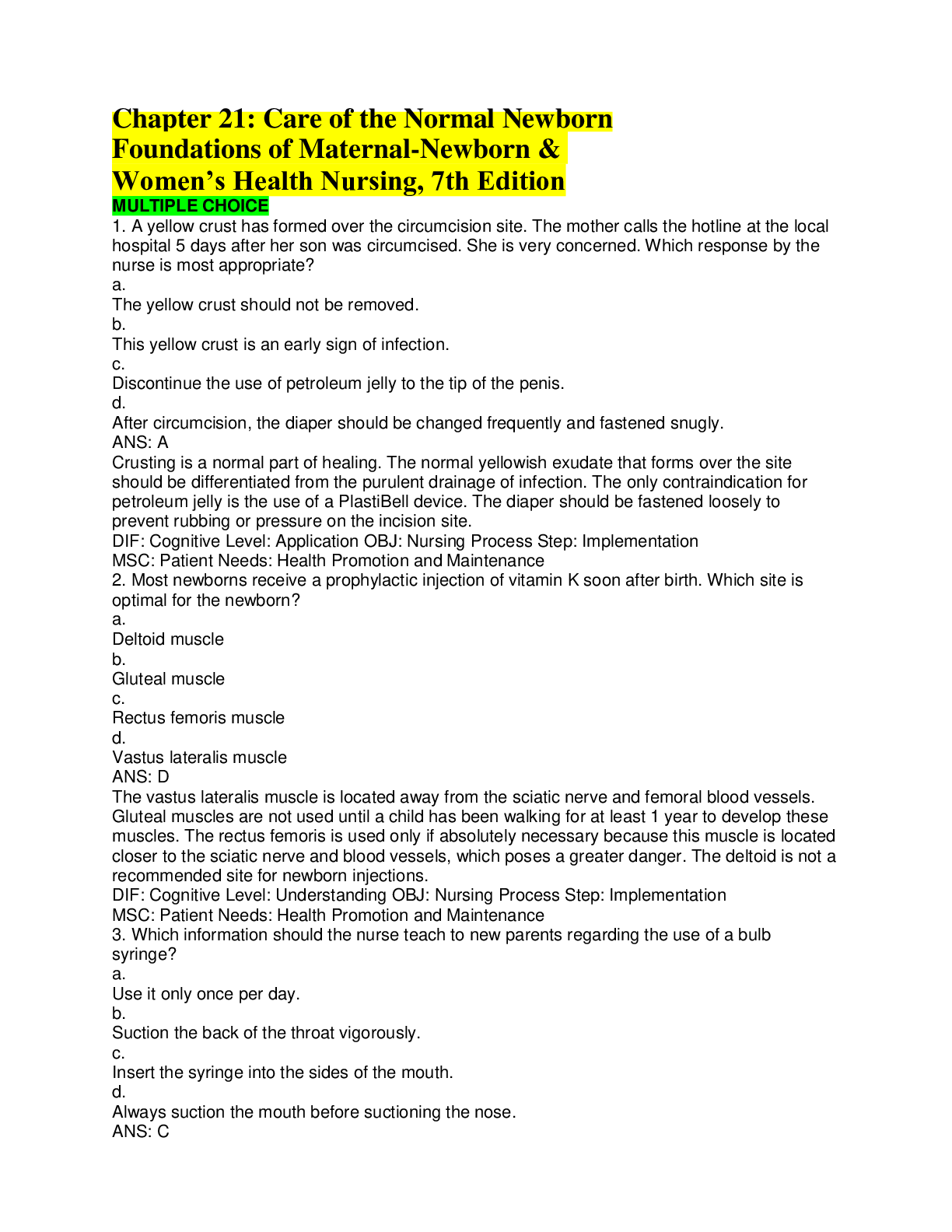
Buy this document to get the full access instantly
Instant Download Access after purchase
Buy NowInstant download
We Accept:

Also available in bundle (1)
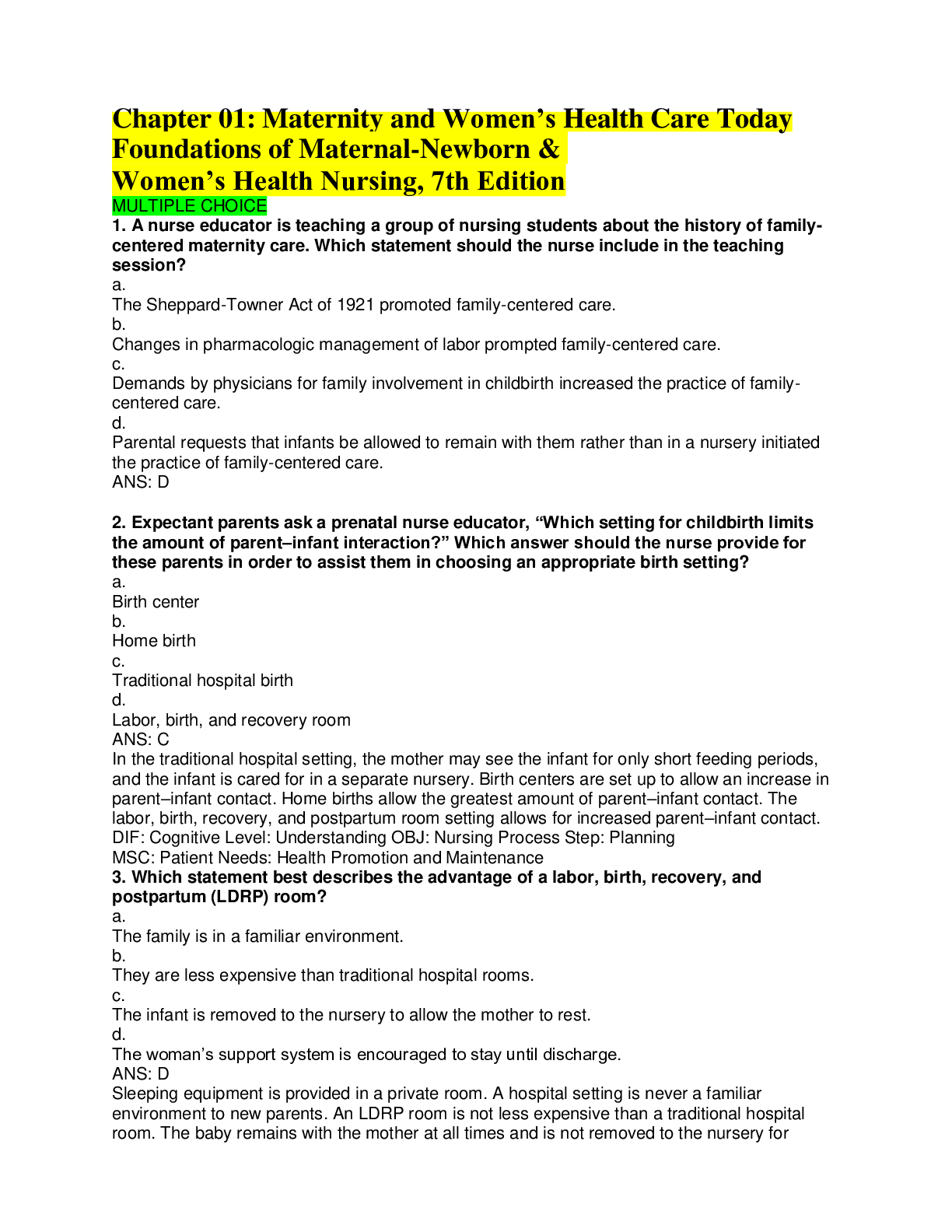
Foundations of Maternal-Newborn and Women's Health Nursing 7th Edition TEST BANK Chapter 1-27
Foundations of Maternal-Newborn and Women's Health Nursing 7th Edition TEST BANK Chapter 1-27
By PROF 4 years ago
$30
3
Reviews( 0 )
$12.00
Can't find what you want? Try our AI powered Search
Document information
Connected school, study & course
About the document
Uploaded On
Jul 05, 2021
Number of pages
64
Written in
Additional information
This document has been written for:
Uploaded
Jul 05, 2021
Downloads
0
Views
113

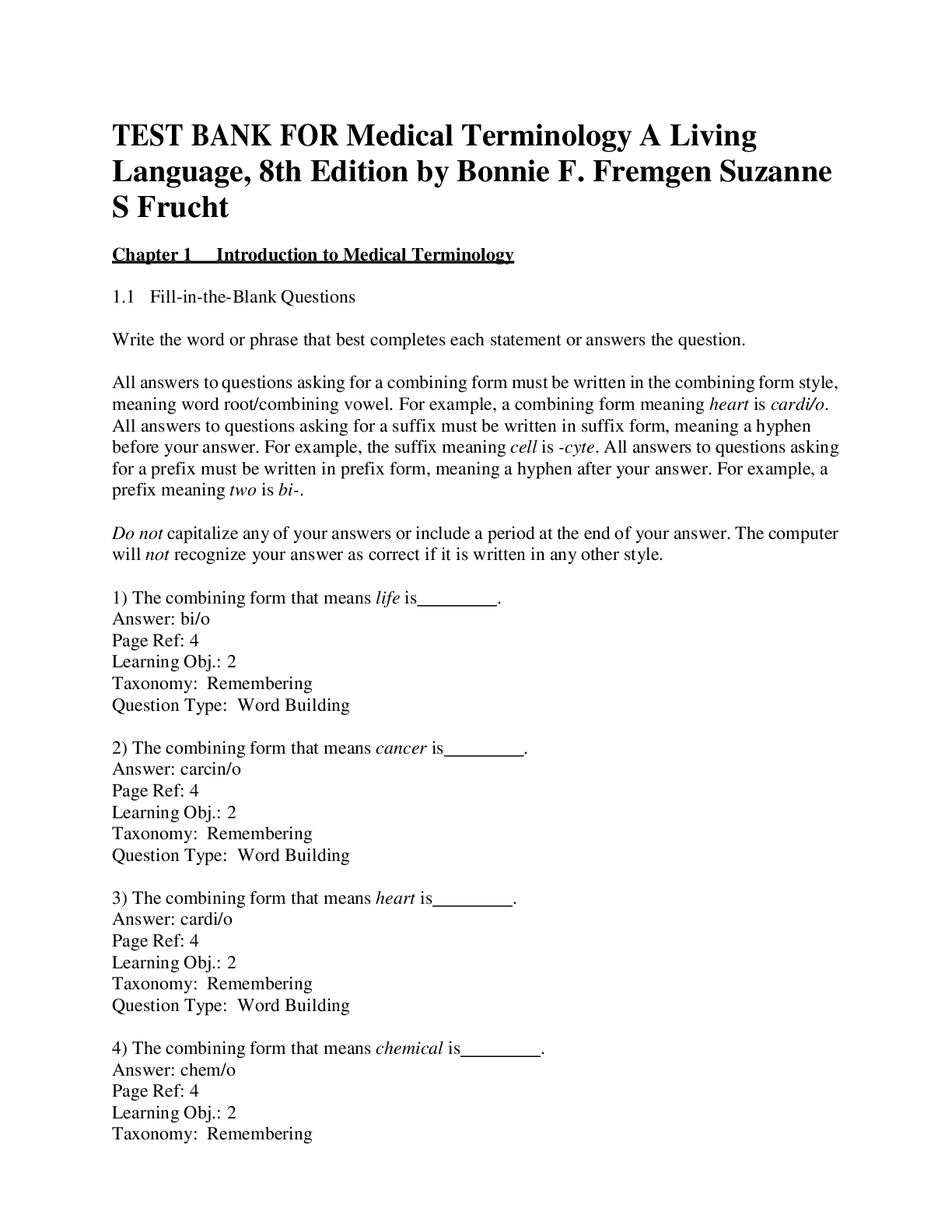
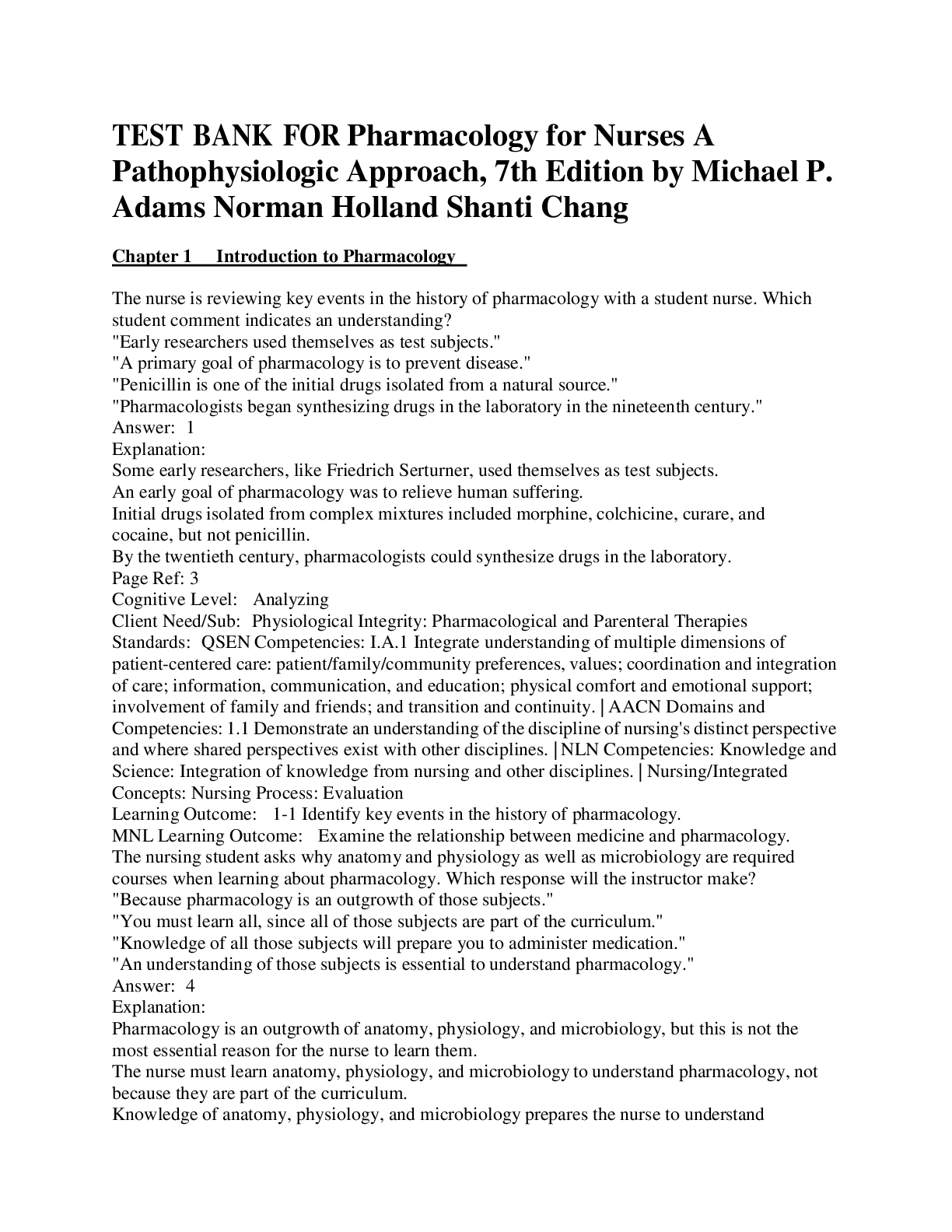

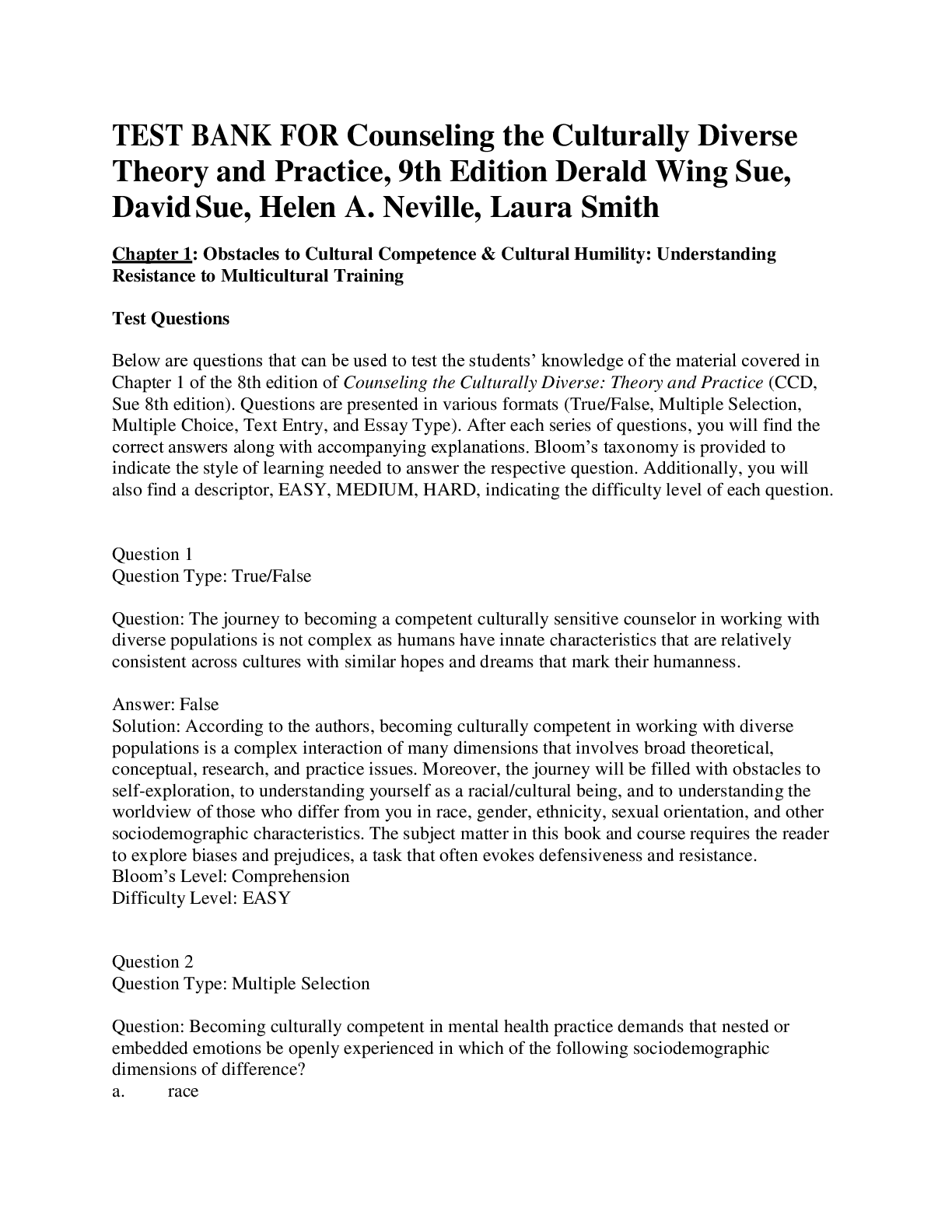
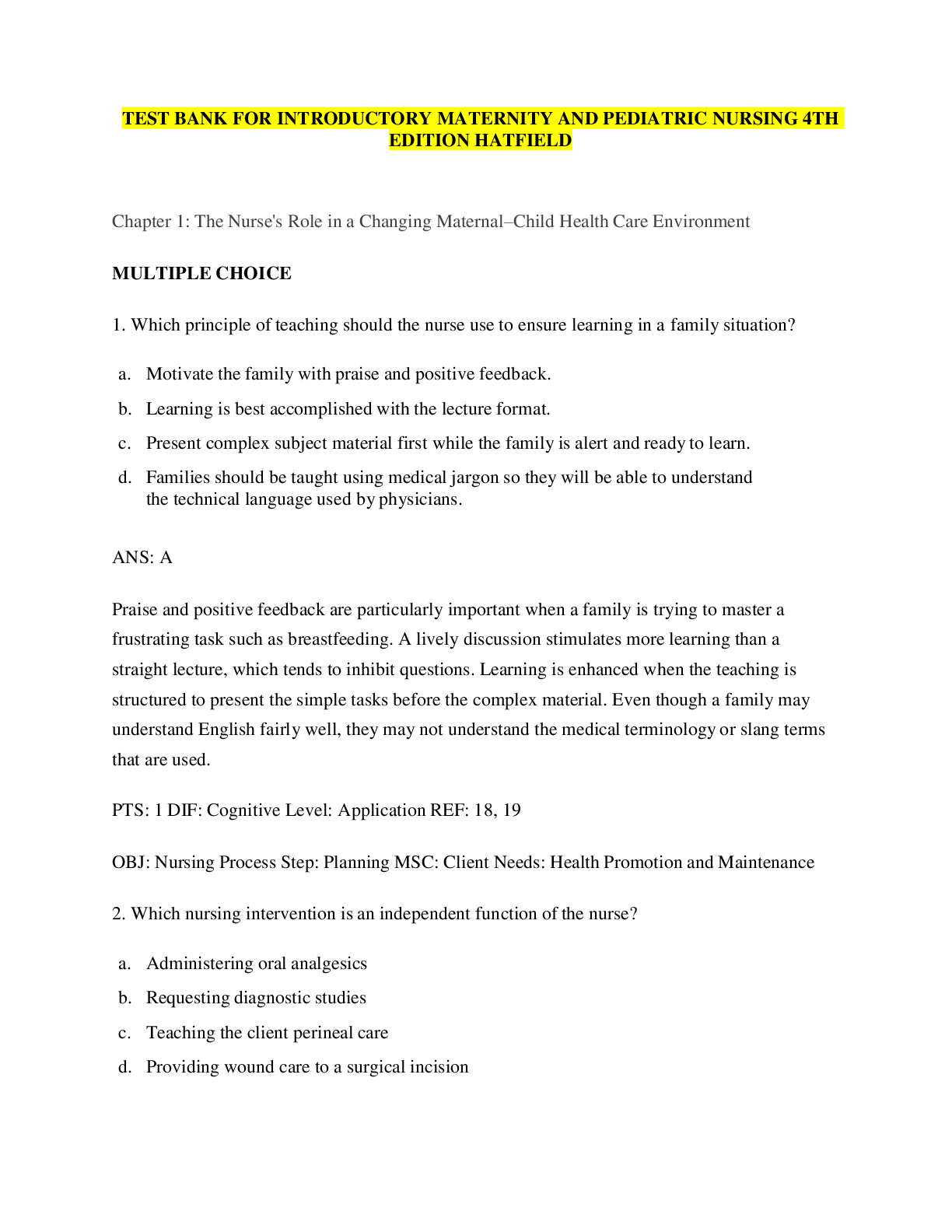
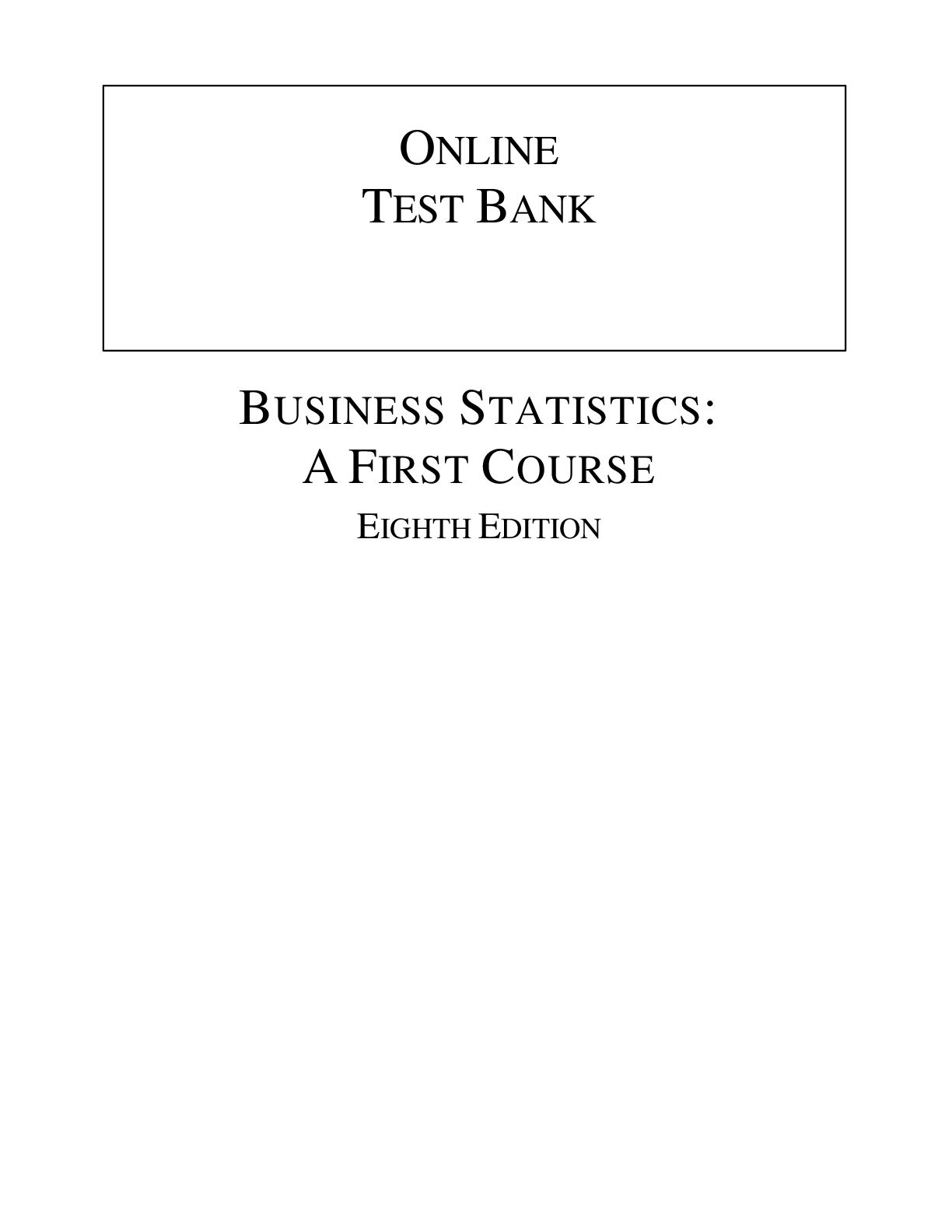
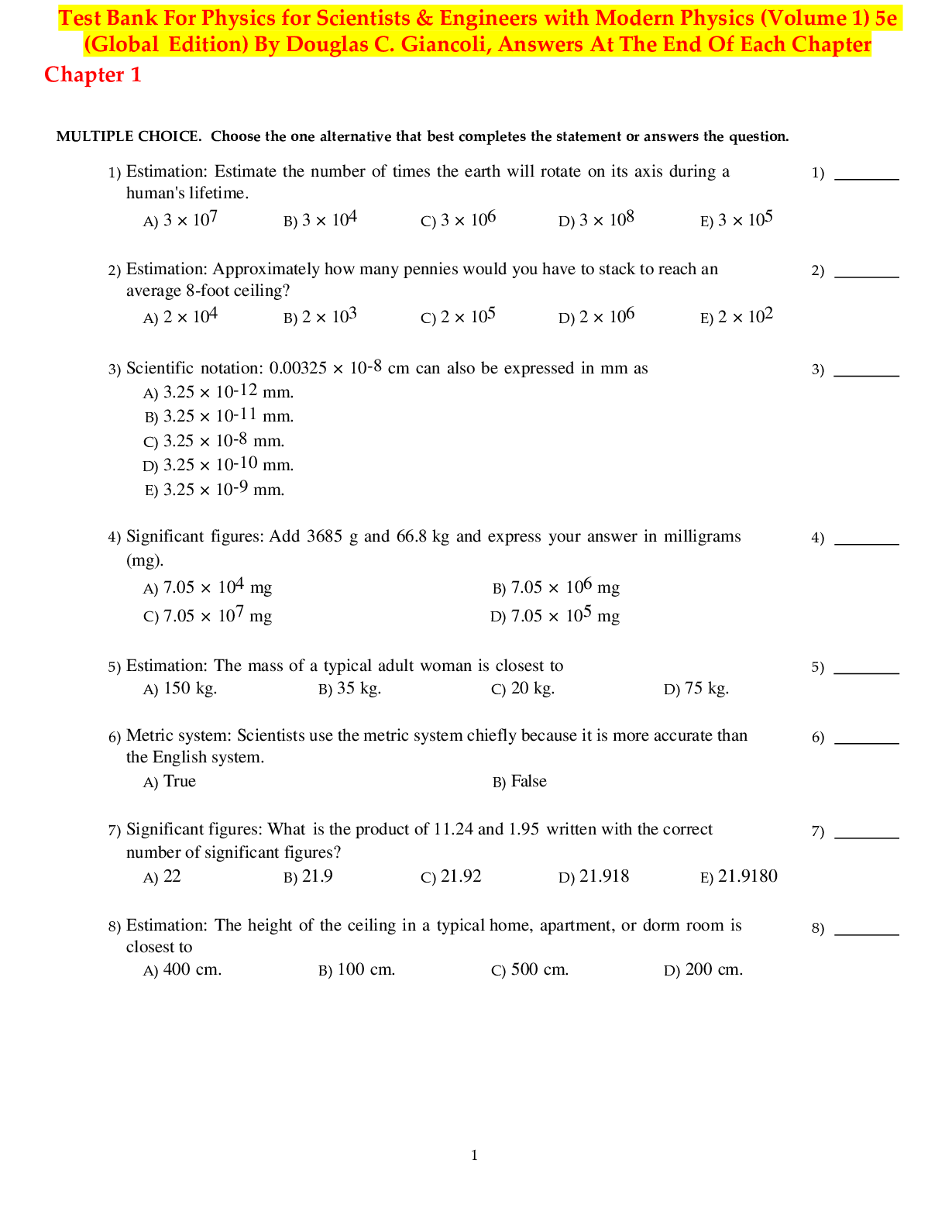

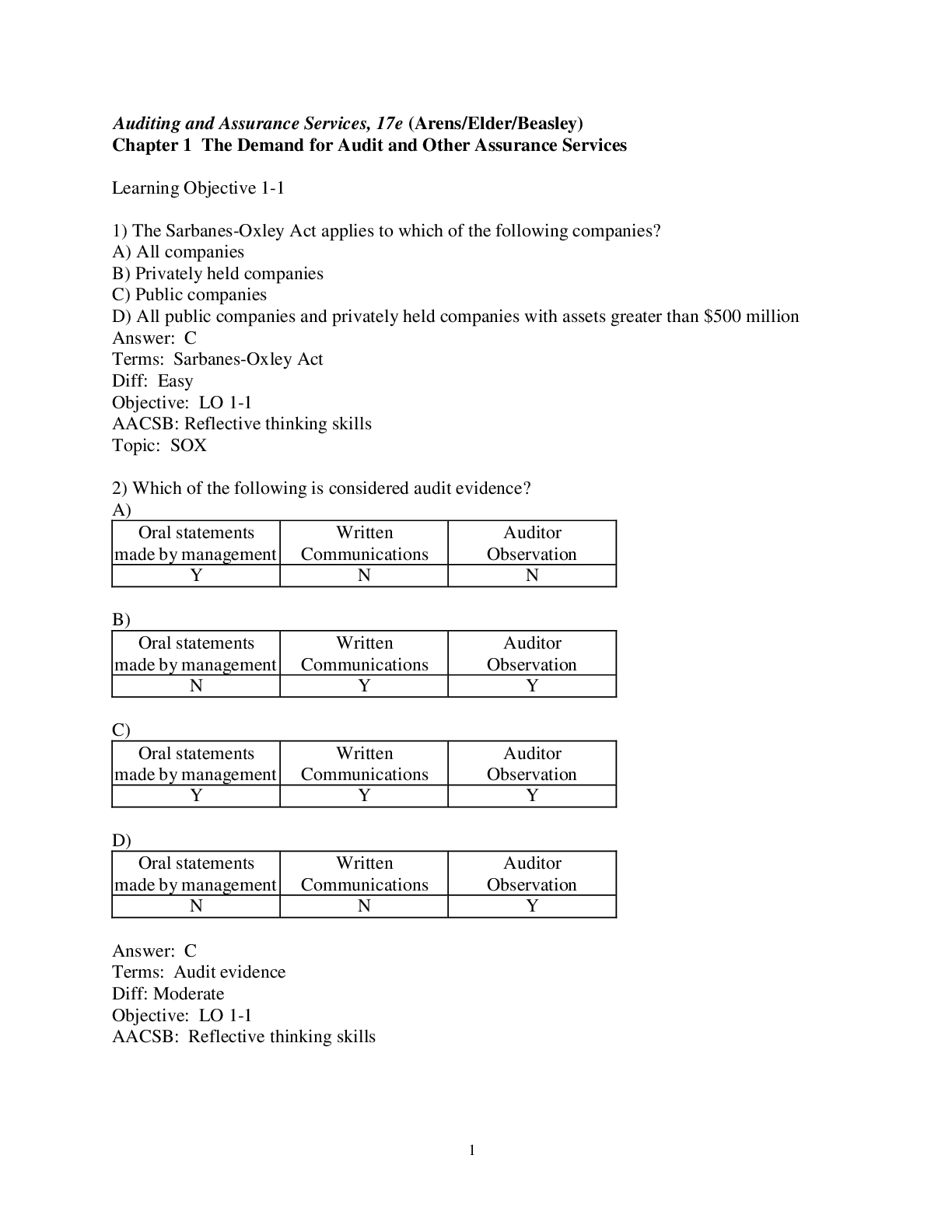
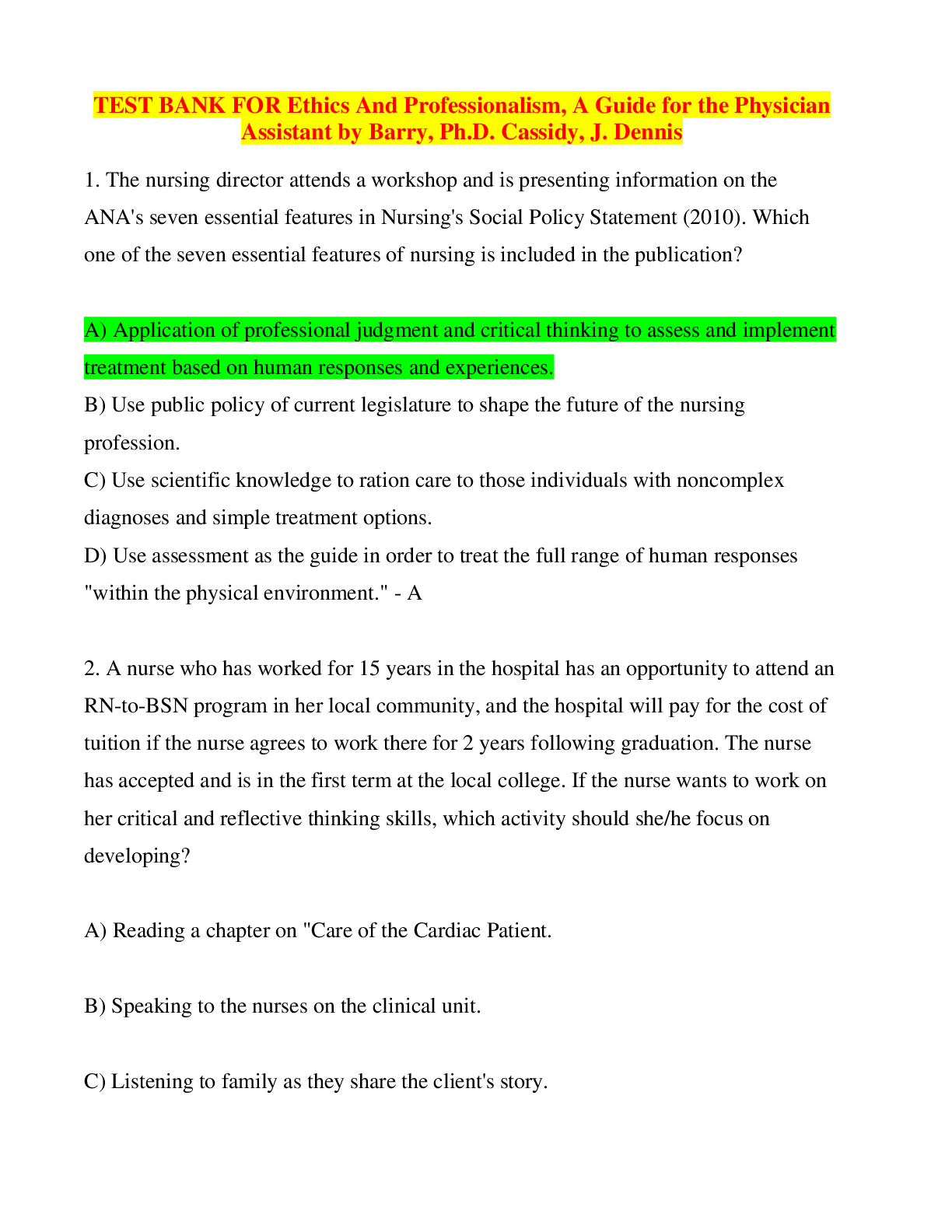

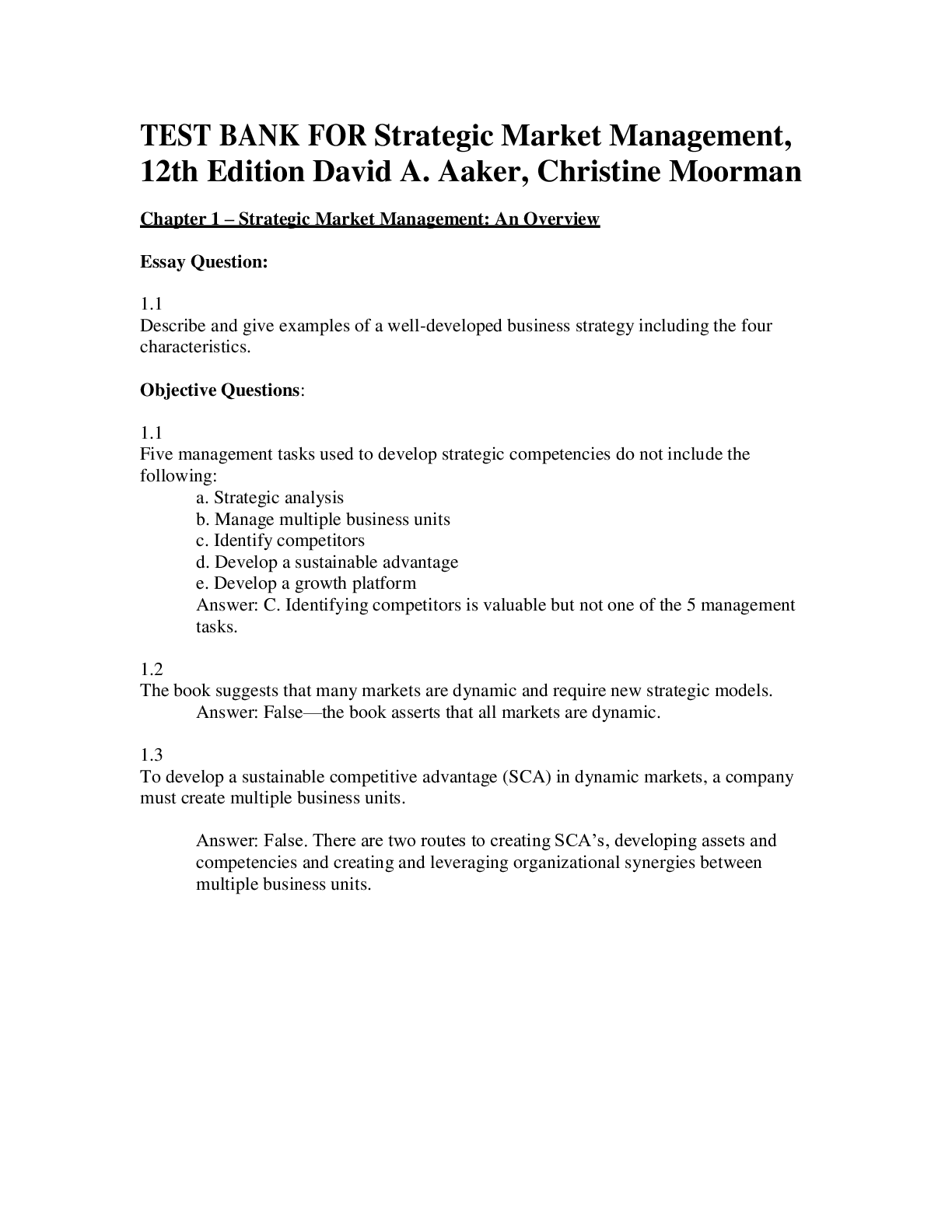




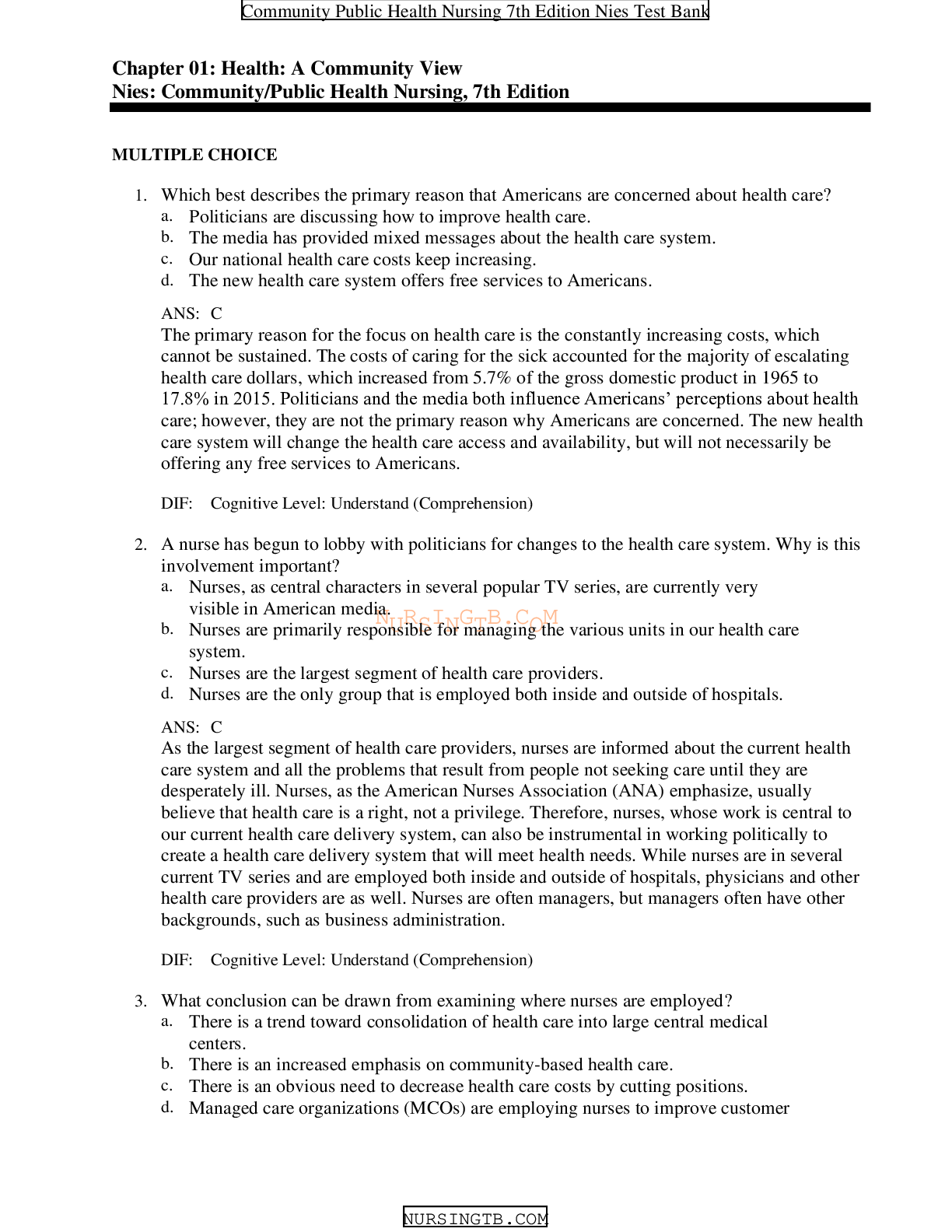
.png)


